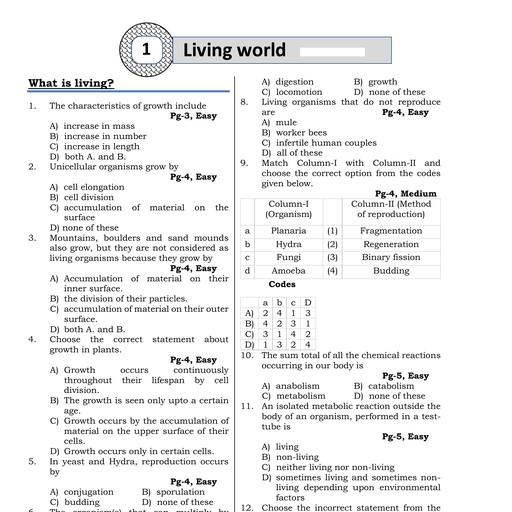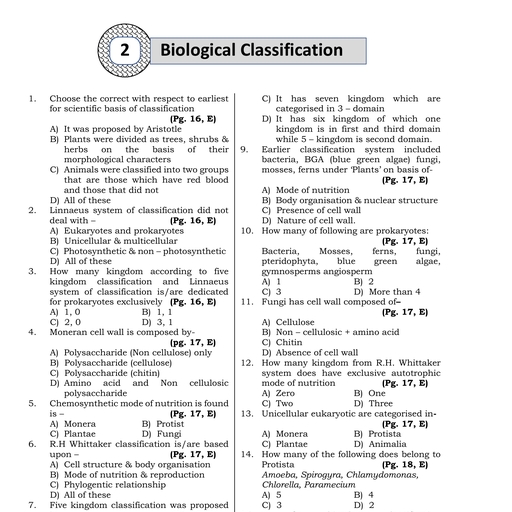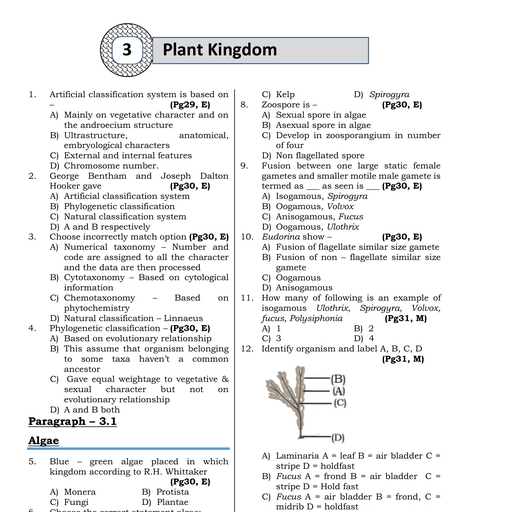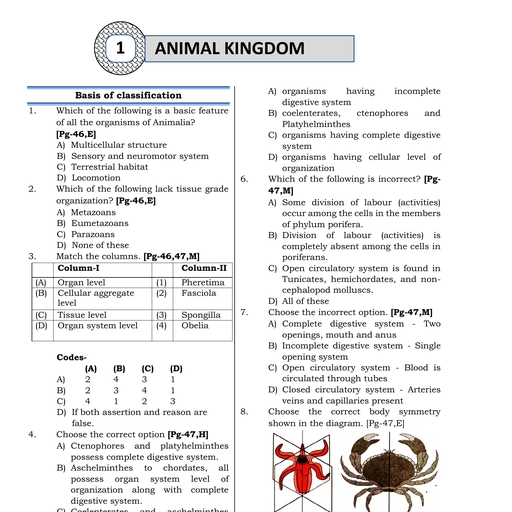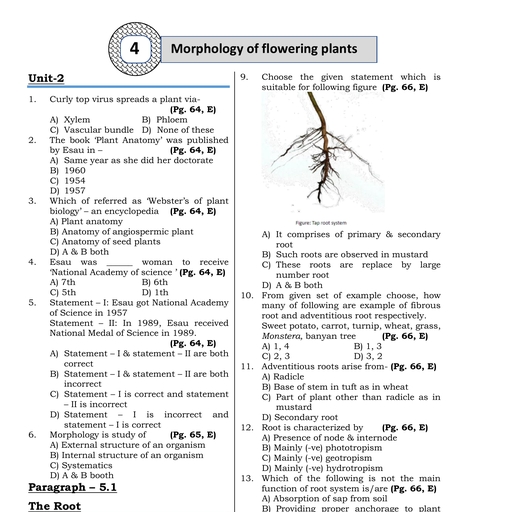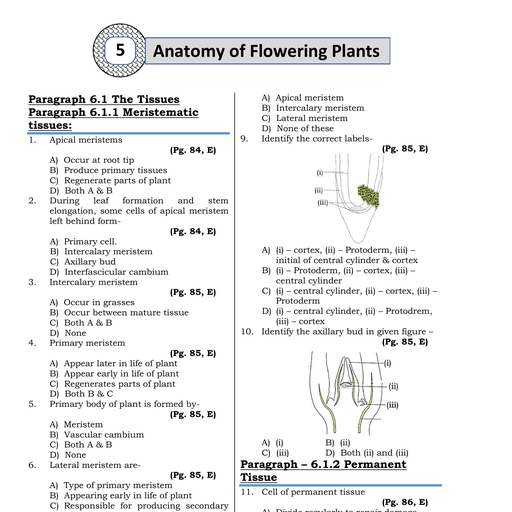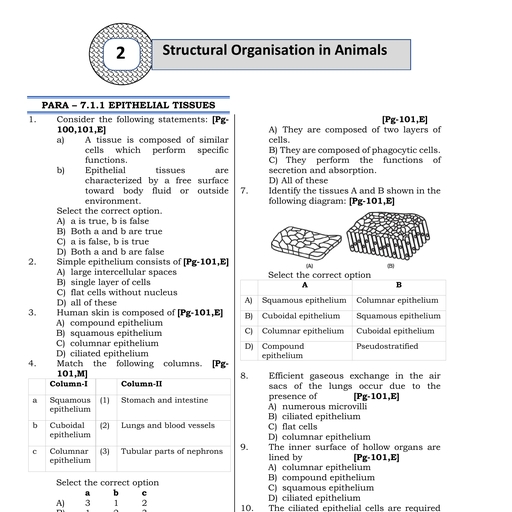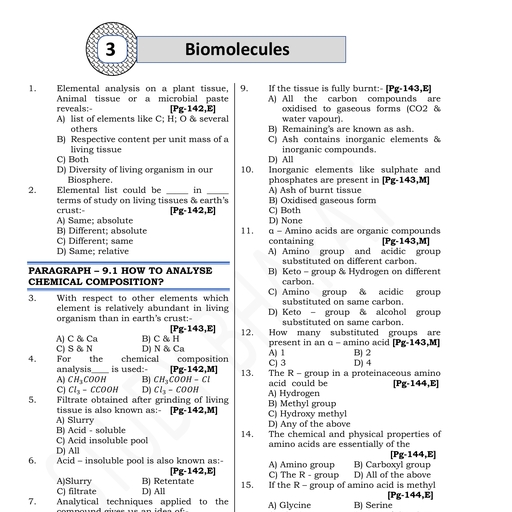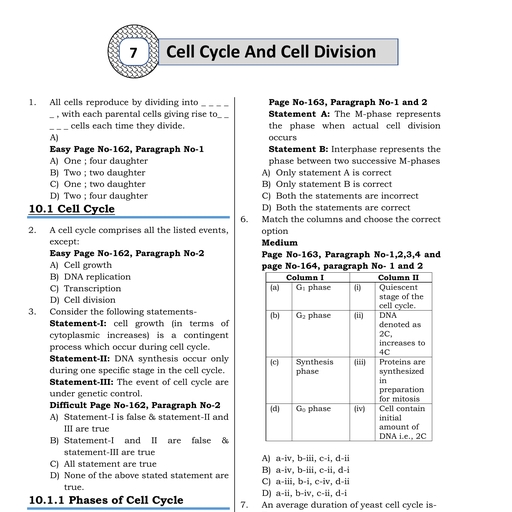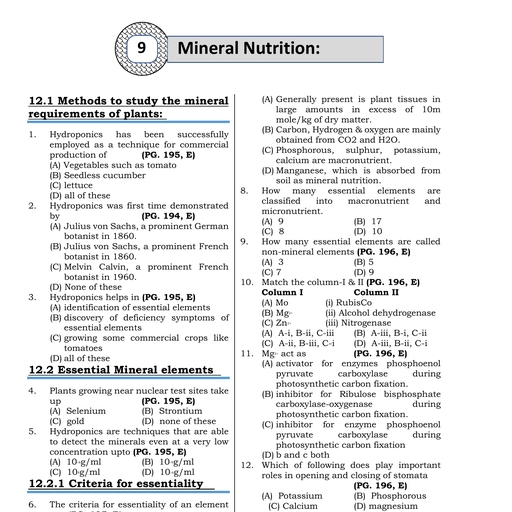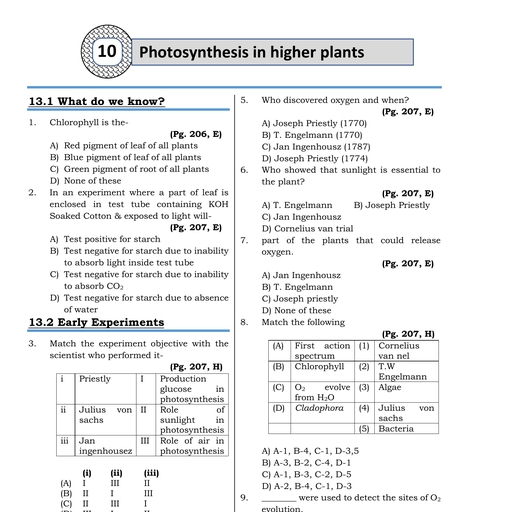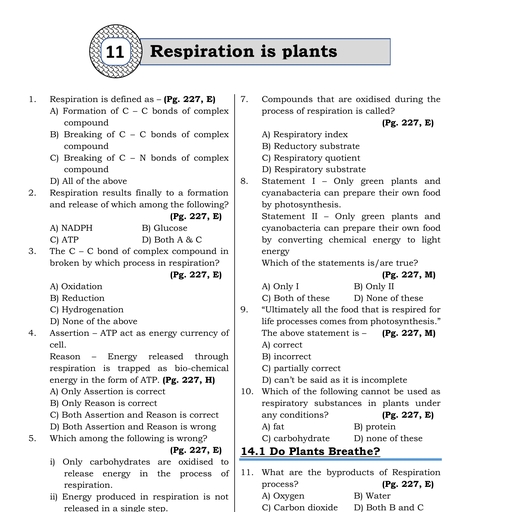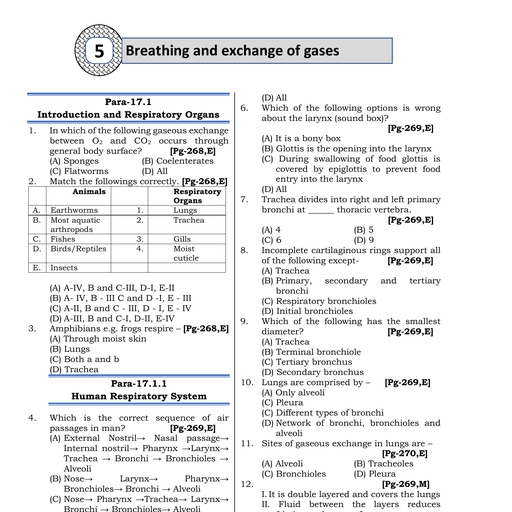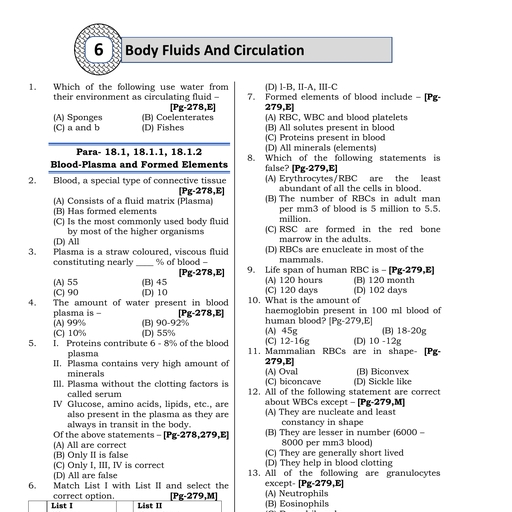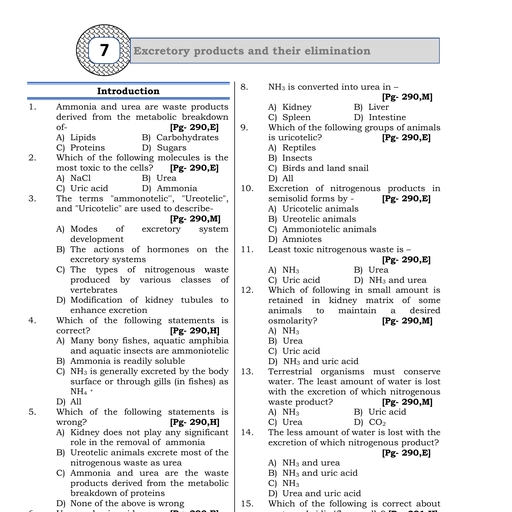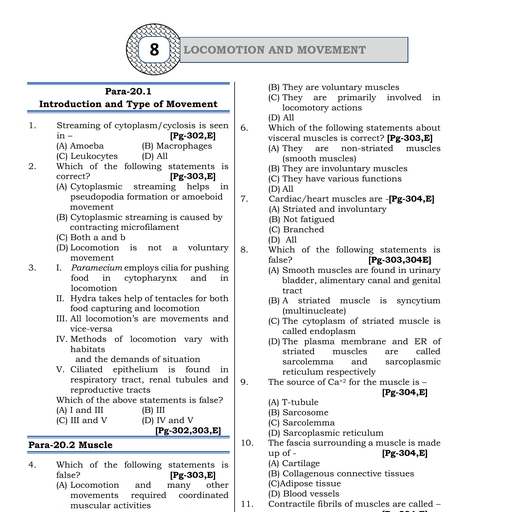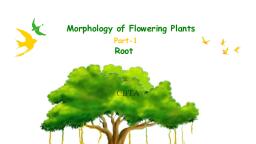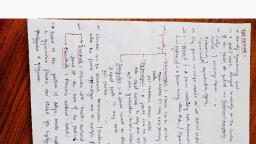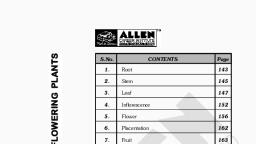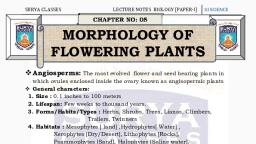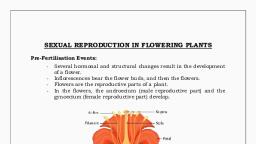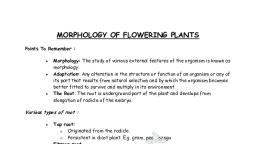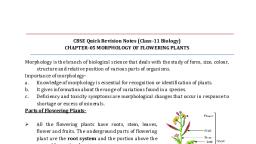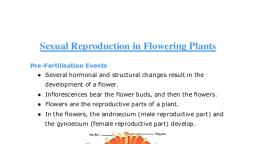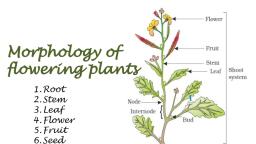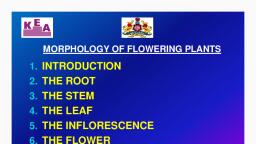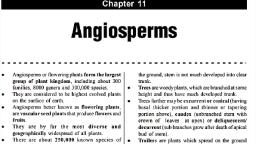Page 1 :
Pre-Medical, MORPHOLOGY OF FLOWERING PLANTS, ROOT, Radicle comes out/arise from the seed coat in the form of soft structure and move toward the, soil. It develops and forms primary root., TYPES OF ROOTS, Roots are of two types :, 1., , Tap root :–, , 1., , Tap root, , 2., , Adventitious root, , It develops from radicle which is made up of one main branch and other sub-, , branches. eg. : Dicots, 2., , Adventitious roots :– In some plants after sometime the growth of tap root which arises from, radicle stops and then roots develop from other part of plant which are branched or unbranched,, fibrous or storage, are known as adventitious roots. eg. : Monocots, , 3., , Fibrous roots :-In monocot plants, the primary root is short lived and is replaced by a large, number of roots. These roots originate from the base of the stem and constitute the fibrous, root system. Eg.:-wheat plant, , MODIFIED ROOTS, Tap and adventitious roots are modified in different forms to perform special functions are called as, modified roots., 1., , Modified tap root for storage :, (i), , Fusiform roots/Spindle root - These root are thicker in the middle and tapering on both, , ends. In this type of roots root help in storage of food. Eg. :- Radish, (ii), , Conical roots - These roots are thicker at their upper side and tapering at basal end eg. Carrot, , (iii), , Napiform - These roots become swollen and spherical at upper end and tapering like a, , thread at their lower end. Eg. Turnip (Brassica rapa), Sugarbeet (Beta vulgaris), (iv), , Tuberous root - Such roots do not have regular shape and get swollen & fleshy at any, , portion of roots. Eg. Mirabilis., (v), , Nodulated root - Nodules are formed on branches of roots by nitrogen fixing bacteria., , (Rhizobium)., 156
Page 2 :
Biology, Eg. Plants of leguminosae family (Papilionatae) - Pea, , 2., , Tap root modified for respiration, The plants which grow in marshy, areas, scarcity of oxygen is found., The plants, which grow in this, region some branches of tap root, grow vertically upward and comes, on surface of soil. These roots are, called pneumatophores have minute, pores called pneumathodes or, lenticels by which air entered the, p l ant, , and, , g et, , oxy ge n, , for, , respiration., Eg. Rhizophora, Mangrove, Heritiera, , Modification of adventitious roots :, (i), , Tuberous adventitious root : When food is stored in these roots, they become swollen and, form a bunch., Eg. Sweet potato (Ipomoea batatus), , (ii), , Fasciculated roots - These are adventitious roots occuring in clusters and all of them are, Swollen. (These roots have no definite shape) Eg. Asparagus, Dahlia, , (iii), , Fibrous - Roots are very thin and filamentous. Eg. Grass, Wheat, , (iv), , Nodulose - In this type, tips of roots swell up. Eg. Melilotus, Curcuma amada, , (v), , Beaded or moniliform - When root swells up like a bead at different places after a regular, interval. Eg. Vitis, Momordica (Bitter gourd), Portulaca, , (vi), , Stilt roots or brace roots - When root arises from lower nodes and enter in side the soil and, form a rope like structure, known as stilt roots Eg. Maize, Sugarcane, Pandanus (screwpine), 157
Page 3 :
Pre-Medical, , (vii) Prop root or pillar roots - When root arises from branches of plant and grows downward, towards soil function as supporting stem for the plant. This type of roots are called prop root, Eg. Banyan, (viii) Butress root - Such roots appear from the basal part of stem and spread in different directions, in the soil. Eg. Terminalia, (ix), , Climbing roots - These roots arise from nodes and helps the plant in climbing Eg. Money plant, (pothos), Monstera, Betel (Piper betel), Black pepper, , (x), , Respiratory root - When the quantity of oxygen is low in soil then some root comes out from, the soil and helps in respiration. Eg.Avicennia, Jussiaea, , (xi), , Foliar root or Epiphyllous root :– When roots arise from leaf are called as foliar roots, Eg. Bryophyllum, Begonia, , (xii) Sucking or haustorial roots or Parasitic roots :– In parasitic plants, roots enter in the stem, of host plant to absorbed nutrition from host. Eg. Dendrophthoe, Cuscuta, Viscum., (xiii) Annulated roots : If the swelling is in a series of ring on the roots. Eg. Ipecac, Note : Some adventitious roots are also produced through branch cutting, when branches are, put into the soil as in Rose, Sugarcane, Tapioca or when kept in water as in Coleus., , 158
Page 4 :
Biology, STEM, Stem is a part of plant which lies above from surface of soil i.e. it shows negative geotropic, growth. It has nodes and internodes. Branches, leaf, flower bud and bracts are developed from, nodes., The main function of the stem is spreading out branches bearing leaves, flowers and fruits. It, conducts water, minerals and photosynthates. Some stems perform the function of storage of, food, support. protection and of vegetative propagation., Forms of stem :–, 1., , Strong stem (Erect stem) :, (a), , Caudex :– It is unbranched, erect, cylindrical stout stem and marked with scars of fallen, , leaves as in palms., Eg :– Palm., (b), 2., , Culm :– Stem is jointed with solid nodes & hollow internodes. Eg :– Bamboo (Gramineae)., , Weak stem : They are of three types :, (i), , Trailing - It is a weak stem that spreads over the suface of the ground without rooting at, , the nodes., (a), , Prostrate or procumbent :– If the stem trails on the ground and lie prostrate., Eg :– Evolvulus and oxalis (Wood sorrel), , (b), , Decumbent :– Stem trails for some distance and then tends to rise at its apex., Eg :– Tridax, Portulaca, , (c), , Diffuse :– When the branches of the stem are spread out in all directions on the ground., Eg :– Euphorbia, Boerhaavia, , (ii), , Climbers :– Stem which attach themselves to nearby object by means of some special, , devices like hooks, tendrils. Eg. Bougainvillea (by hook), wild pea (by tendrils), (iii), , Creeping : The plant grows horizontally on the ground and gives off roots at each nodes., , Modification of stem :–, A - sub-aerial modification - These are creeping stem., (1), , Runner - When stem grows and spread on the surface of soil. Roots are developed at lower, side and leaves from upper side from node Eg. Cynodon dactylon (Doob grass), Oxalis., , (2), , Stolon - In it branches develop from the lower part of the main stem growing some distance, like arch and finally touching ground to give rise to new shoot. Eg. Fragaria (Wild strawberry), , Jasmine, Peppermint, , (3), , Sucker - In it the main stem grow in the soil but branches develop from nodes and comesout, from the soil. Eg. Mint, Pineapple, Chrysanthemum., , (4), , Offset - Generally these occur in aquatic plants which have fragile stem. Internodes of offset, are small & thicker. It is also known as aquatic runner. Eg. Pistia, Eichhornia, 159
Page 5 :
Pre-Medical, , B – Underground modification, This type of modification occurs generally for food storage and vegetative propagation., (1), , Tuber - The tips of branches become swollen in the soil. Eyes are found on them which are, axillary buds and covered with scaly leaves. Eg. Potato, , (2), , Rhizome - It is fleshy and horizontally found below in soil small nodes and internodes are found, which are covered by scaly leaves. Eg. Ginger, Turmeric, Canna, Water lily, , (3), , Corm - It is condensed structure which grow vertically under the soil surface. Eg. Colocasia,, Alocasia, Zaminkand, Saffron., , (4), , Bulb - This stem has disc like structure and surrounds with numerous fleshy scaly leaves. Many, roots arise from its base. Eg. Onion, Garlic., , 160
Page 6 :
Biology, C - Aerial modification, (1), , Stem tendril - In this type axillary bud forms tendril in place of branches and helps in climbing, of those plants which have weak stem. Eg. Grapes, Passiflora, Cucumber, Pumpkins,, Watermelon, , (2), , Phylloclade - Stem is modified into a flat (Opuntia), fleshy Cylindrical (Euphorbia) and, green leaf like structure and carries out photosynthesis like leaf. The leaves are modified into, spines Eg. Opuntia, Euphorbia, Casuarina., , (3), , Prickle and hooks - These developed only from cortex and epidermis and found at nodes or, internodes. It helps in climbing. It is exogenous in origin., Eg. Rose, Smilax, , (4), , Stem thorn/Thorn - It is developed from axillary bud or terminal bud of the stem. It may bear, leaves, flowers. It is endogenous in origin. Eg. Carissa (Karonda), Bougaivillea, Pomegranate, Citrus, , LEAF, The leaves develop from the nodes. Their main function is photosynthesis and food making, axillary buds are found in its axil. Leaves originate from shoot apical meristems and are arranged, in an acropetal order., Leaf is divided into 3 main parts :–, (1), , Leaf base - The part of leaf attached to stem, , (2), , Petiole - The part of leaf connecting the lamina with the branch or stem, petiolated or stalked, leaves are known as petiolate and when petiole or stalk is absent then leaves are called sessile., In Eichhornia petiole swells and in citrus it is winged., , (3), , Lamina (Leaf blade) - It is a broad and flattened part of leaf., , Its main functions are, , photosynthesis and transpiration., Stipules :–, Leaves of some plants have lateral appendages on either side of leaf base, known as stipules., If stipules are present in leaf it is called stipulated leaf, if it is absent then leaf is called exstipulated., 161
Page 7 :
Pre-Medical, Stipules are of various types 1., , Free lateral- They are independently present on both sides of leaf base. Eg. Hibiscus, rosasinensis (China rose)., , 2., , Interpetioler - When two leaves are meet oppositely at the node then two nearest stipules of, adjacent leaf joint with each other. In this way only two stipules of two leaves are found in, place of four Eg. Ixora., , 3., , Intrapetioler - In this type both stipules of a single leaf join with each other to form a single, stipule., Eg :– Gardenia, , 4., , Foliaceous - These type of stipules form a leaf like structure. Eg. :– Pea, , 5., , Scaly - Stipules are dry, small and paper like. Eg :– Desmodium, , 6., , Spiny - Stipules modified into spines. Eg. Zizyphus (Ber), , 7., , Ochreate - When both stipules of leaf combine together and form a tube like structure, it is, called ochreate. Eg. polygonum, , 8., , Adnate - Both stipules are joint with petiole. Eg. Rose., , 9., , Tendrillar - Stipules are modified into tendrils like structure. Eg. Smilax, , Types of Leaves 1., , Foliage leaf - They are usually green coloured and their main function is photosynthesis., , 2., , Cotyledonary leaf - This leaf comes out during germination and helps in nutrition untill the, first leaf is not formed., , 3., 162, , Scale leaf - Such leaves are usually dry membrane like and they can not perform photosynthesis.
Page 8 :
Biology, , 4., , Bract - Bract are the leaves which contain flower in their axil., , 5., , Bracteole - These are leaf like structure found on pedicel., , 6., , Floral leaf - Sepals, petals , stamen and carpel are found in flower which are included in this, type of leaf., Note : Perianth : In some flowers, Calyx and Corolla are not distinct and are termed as, Perianth, and unit of perianth is called tepal. Eg. Lily, , Duration of Leaf :, 1., , Persistent/Evergreen - Leaves of such plants are found in all season and do not (fall) shed, combindly. Eg. Pine, Saraca indica, Datepalm., , 2., , Deciduous - All leaves of such plants shed at the same time Eg. Azadirachta, Ficus, , 3., , Caducous - Leaves shed as the bud formation takes place. Eg :– Rose, , NOTE :, 1., , Cauline leaves - When the leaves are found on node of stem, then they are called cauline, leaves., , 2., , Ramal leaves - When leaves are found on branches, then they are called ramal leaves., , 3., , Radical leaves - During favourable season ,leaves develop from the nodes of under ground, stem and seem that they are developing from roots. This type of leaves are known as radical, leaves., , VENATION OF LAMINA, The arrangement of veins and veinlets in leaves (Lamina) is known as venation. It is of 2 - types, (1) Reticulate. It is found in dicots. Exception – Calophyllum (It has parallel venation), (2) Parallel. It is found in monocots. Exception – Smilax (It has reticulate venation), 163
Page 9 :
Pre-Medical, 1., , Reticulate venation - In this type of venation many veins are divided into various branches, (veinlets) and form a net like structure., Reticulate venation is of 2- types (a), , Unicostate or pinnate - This type of venation is having only one principal vein or midrib, , that give off many lateral veins which proceed toward margin and apex of lamina of the leaf and, form a network., Eg. :– Mango, Guava, Peepal., (b), , Multicostate or palmate - In this type of venation many principal veins arising from the, , tip of petiole and proceed upward, this is again of two types (i), , Multicostate divergent - Many principal veins arising from the tip of petiole diverge from, , one another towards the margin of leaf blade eg. Cotton, Castor, Cucurbita., (ii), , Multicostate convergent - Many principal veins arising from the tip of petiole. At the, , base of leaf they are closely arranged but diverge from one another in middle part and converge, towards the apex of leaf. Eg. :– Camphor, Zizyphus, Tejpat, Chinarose, Plum., , 2., , Parallel venation - In this type of venation, all veins run parallel to each other and they donot, form network., They are of 2 types (1), , Unicostate or pinnate : This type of pattern having only one principal vein, that gives, , off many lateral veins, which proceed toward the margin of leaf blade in a parallel manner but, they donot have veinlets., Eg. Banana, Ginger, Canna, (2), , Multicostate or palmate : Having many principal veins arising from the tip of the petiole, , and proceeding upwards., (a), , Multicostate divergent : Many principal veins arising from the tip of petiole and diverge, , toward the margin of leaf. They donot divide into veinlets and do not form network., Eg. :– Coconut, Fan palm., (b), , Multicostate convergent : Many principal veins arising from the tip of petiole run in a, , curved manner in lamina and converge towards the apex of leaf blades., Eg. :– Wheat, grass, sugar–cane, Bamboo, 164
Page 10 :
Biology, , Modification of leaves - When leaf is modified in different structure. It is called modification of, leaves., (1), , Leaf tendril - In this, whole leaf is modified into a wire like structure which is called leaf tendril, Eg. Lathyrus aphaca (wild pea), , (2), , Leaf spine - Leaves or any part of leaflet are modified into pointed spine. Eg. Opuntia, Aloe,, Argemone., , (3), , Leaf scale - In this leaves become thin, dry and form a membrane or paper like structure, and serve to protect axillary buds as in Ficus and Tamarix, Ruscus or store food and water as, in onion., , (4), , Leaf pitcher - Leaves of some plants are modified to pitcher shape. Eg. Nepenthes, Dischidia, , 165
Page 11 :
Pre-Medical, (5), , Leaf bladder - In some plant, leaves are modified into bladder like structure eg. Utricularia, , (6), , Leaf Hooks - In some plants terminal leaf lets are modified into curved hooks for helping the, plant in climbing. Eg. Cat's nail (Bignonia unguis - cati)., , (7), , Phyllode - In it petiole becomes flat structure and function as normal leaf. Eg. Australian, acacia, , (8), , Leaflet tendril - When leafleat is modified into tendril like structure than it is called leaflet, tendril. Eg. :– Pisum sativum (Garden Pea), Lathyrus odoratus (sweet pea)., Note : Dionaea (Venus flytrap) is insectivorous plant and they also have modified leaves., , Simple and Compound Leaf, (1), , Simple Leaf : A leaf which may be incised to any depth, but not up to the midrib or petiole, then this type of leaf called simple leaf., , (2), , Compound leaf : A leaf in which the leaf blade is incised up to the midrib or petiole, thus, dividing it into several small parts, known as leaf lets., , It has two types :–, (A), , Pinnately compound leaf : In this type of leaf mid rib is known as rachis. Leaf lets are, arranged on both sides of rachis. Eg. Neem, , It is of four types, (i), , Unipinnate : In this type of leaf divison occurs only once and leaf lets are directly, , attached on both sides of rachis. If the number of leaflet is even, then leaf is known as, paripinnate. Eg. : Cassia fistula, Sesbania, If the number of leaflet is odd, it is known as imparipinnate. Eg. :– Rose, Neem, (ii), , Bipinnate : A twice pinnate compound leaf. Eg. :– Acacia, Gulmohar, Mimosa, , (iii), , Tripinnate : A thrice pinnate compound leaf. Eg. Moringa, , (iv) Decompound : A compound leaf, which is more than thrice pinnate. Eg :– Carrot,, Coriander, , (B), , Palmate compound : In this type incision of leaf are directed from leaf margin to apex of, petiole and all leaflets are attached on the upper end of petiole. Eg. Silkcotton., It is of following types :, , 166, , (i), , Unifoliate : When single leaf let is found. Eg. :– Lemon, , (ii), , Bifoliate : When two leaf lets are present. Eg. :– Bauhinia, Regnelidium, , (iii), , Trifoliate : When three leaf lets are attached. Eg. :– Oxalis, Aegle.
Page 12 :
Biology, (iv), , Tetrafoliate : When four leaf lets are attached to the petiole. Eg. :– Marsilea, , (v), , Multifoliate : When more than four leaflet are found, then leaf is called multifoliate, , palmate compound leaf. Eg. Silkcotton., , PHYLLOTAXY :Phyllotaxy : Phyllotaxy is the pattern of arrangement of leaves on the stem or branch., This is usually of three types., (i), , Alternate : In this type a single leaf arises at each node at alternate manner. Eg. Mustard,, Chinarose, Sunflower., , (ii), , Opposite : In this type of phyllotaxy a pair of leaves arise at each node and lie opposite to each, other., It is of two types (a), , Superposed : when the pair of leaves stands directly over the lower pair. Eg. Guava, , (b), , Decussate : Each successive pair of leaves stands at right angles to the next one. Eg., , Calotropis, (iii), , Whorled : If more than two leaves arise at each node. It is called whorled phyllotaxy., Eg. Alstonia (Deviltree), Nerium, , (A), , (B), , (C), , (D), (A) Alternate (B) Decussate(C) superposed,(D)Whorled, , 167
Page 13 :
Pre-Medical, INFLORESCENCE, Arrangement of flower on floral axis is called inflorescence., Racemose - In this type of inflorescence the main axis continues to grow and does not, terminate in a flower and give off flowers laterally in acropetal manner (Where old flowers, are arranged lower side and young flowers are upper side)., This is of foll. diff. types :, 1., , Raceme - When peduncle or (main axis) is elongated, and flowers are pedicellate., Eg. Radish, Mustard, When peduncle is branched and each branch bear, pedicelated flowers like racemose and are arranged, in acropetal manner known as compound raceme or, panicle Eg. Gulmohar, Neem., , 2., , Spike - In it peduncle is elongated but flowers are, sessile. Eg. Achyranthes., , When peduncle is branched and each branch bear spike,, like infloresence then the small branch having flower, is called spikelet and this arrangement is called as, spike of spikelet. Eg. in the members of grass family, (Gramineae) wheat, , 3., , Catkin/Amentum - In it peduncle is thin, long and, weak, and flowers are sessile and unisexual, Eg. Mulberry, Betula, Oak., , 4., , Spadix - In it peduncle is thick, long and fleshy and, have small sessile and unisexual flowers covered with, one or more green or colourfull bracts. Eg. Colocasia,, Maize, Aroids, Palms, Grain of maize is fruit long filamentous, threads protruding at the end of a young cob of maize, are styles., , 168
Page 14 :
Biology, 5., , Corymb - In it peduncle is short and all flowers, are present at same level because the lower, flower has much long pedicel than the upper one., eg. Candytuft (Iberis amara) If in this type of, inflorescence peduncle is branched, then each, branch has flower cluster, then this type of, inflorescence is called compound corymb. eg, Pyrus terminalis, , 6., , Umbel - An inflorescence in which the flower, stalks are of more or less equal in length, arise, from the same point, At the base of flowers, stalk, there is whorl of bracts forming the involucre., eg. Centella., If in this type of inflorescence,, , peduncle is, , branched then each branch has flower cluster, then this type of inflorescence is called compound, umbel. eg. coriander, Foeniculum, cuminum., 7., , Capitulum/Racemose head (Anthodium) - In, it the growth of peduncle is retarded and it become, broad, flattened concave or convex. On it small, flowers are found. These flowers are called floret., If all the flower of capitulum are same, then it is called homogamous. If the younger flower, are present towards centre and older towards the periphery, than it is known centripetal, order. The flowers which are present in centre called disc floret and flowers at periphery, are called as ray floret and arrangement of this type is called heterogamous. In this type, of inflorescence florets may be unisexual, bisexual and sterile. This inflorescence is surrounded, by one or more involucre. It is most advanced type of inflorescence, because all flowers, are pollinated at same time. Eg. Sunflower, Zinnia, Marigold., , CYMOSE, In this type of inflorescence, the peduncle terminate in a flower. In it the older flowers, are present at upper portion and young buds are arragned towards base. This arrangement, is called basipetal succession. It is of following types 1., , Uniparous cyme/Monochasial cyme - The peduncle ending in a flower producing lateral, branch at a time ending in a flower. It is two, types (a) Helicoid cyme - When all lateral branches, developed on the same side on peduncle then, it is called helical cyme. Eg. Heliotropism, Saraca., (b) Scorpioid cyme - In this type the lateral, branch develops on one side and the other branch, will develop opposite to first one, i.e. they lie, alternate to each other. Eg. Begonia, Vine., 169
Page 15 :
Pre-Medical, 2., , Dichasial or biparous cyme - In this type peduncle, ends in a flower, from the basal part of peduncle, two lateral branches arise which also end in a, flower now this same arrangement occur on these, lateral branches., Eg. Bougainvillea, Jasmine, Teak, Mirabilis., , 3., , Multiparous cyme/Polychasial - In this type, peduncle ends in a flower and from the base, of it many lateral branches arise, which also, terminated in flower, this arrangement now also, occur on these lateral branches Eg., , Calotropis, , (madar), Nerium, Asclepias, Some species of, croton and Euphorbia., , SPECIAL TYPE OF INFLORESCENCE 1., , Cyathium -, , The bracts or the involucre become fused to form a cup shaped structure, , on the margin of it secretory glands are found. In the central part of cup shaped structure, a female flowers is found, which mature earlier. Due to the growth of pedicel this come, out from the cup shaped structure. Female flowers are surrounded by small male flowers., These are also found on Pedicel. The male flower, which lie toward centre mature earlier, than the flowers which are towards periphery., This inflorescence is found in Euphorbiaceae family like Euphorbia, Poinsettia, Pedilanthus., 2., , Verticillaster - This type inflorescence is found in Labiatae/Lamiaceae family. In this type, of inflorescence leaves are arranged in opposite manner on stem. From the axil of each, leaf inflorescence develops. From the main axil, lateral axil arises, on which flowers are, found. Now from these branches lateral branches developed also. On these branches flowers, are found also. In this inflorescence each dichasial chyme changes into monochasial (scorpioid), cyme. Eg. Salvia, Ocimum, Coleus, , 3., , Hypanthodium - In it peduncle is modified in narrow cup like structure. At the base of, cup female flowers develop while towards mouth male flower develops. All three types of, flowers are present in this inflorescence. Eg. Banyan, Peepal, Ficus species, , 170
Page 16 :
Biology, , 4., , Mixed inflorescence – Some times flowers are arranged in both racemose and cymose, manner on same peduncle called mixed inflorescence., , (i), , Mixed spadix – Banana, , (ii), , Cymose raceme or thyrsus – Grapes., FLOWER, The part from where flower arise is called bract. Flower is short or long on flower stalk, which is called pedicel. The upper part of pedicel is swollen, spherical shaped or conical, which is called thalamus/Receptacle. Floral leaves are present on it., In a flower there are 4 types of floral leaves., (1) Sepal, , (2) Petal, , (3) Stamen, , (4) Carpel, , 171
Page 17 :
Pre-Medical, Symmetry of flower, If the floral leaves are cyclic arranged in a flower, then it is called cyclic flower., If floral leaves are spirally arranged then it is called spiral or acyclic flower., Actinomorphic/Radial/Regular - When flower is divided by any vertical plane into two, equal halves, then it is called actinomorphic flower eg. Mustard, China rose, Datura, Chilli, 2, , Zygomorphic/Bilateral - When the flower is divided into two equal halves only by one, vertical plane, then it is called zygomorphic flower. eg. Pea, bean, Gulmohur, Cassia, If from median plane, it is divided into two equal halves, then it is called medianly zygomorphic,, Eg. Ocimum (Tulsi)., But if by lateral plane it is divided into two equal halves, then it is called laterally zygomorphic., , 3., , Asymmetrical/Irregular - When the flower cannot be divided into two equal halves from, any plane, then it is called asymmetrical flower. eg. canna., , NOTE (1), , Anthophore - Elongated internode between calyx and corolla is called anthopore. Eg. Silene, , (2), , Androphore - Elongated internode between corolla and androecium is called androphore., Eg. Passiflora., , (3), , Gynophore - Elongated internode between androecium and gynoecium is called gynophore., Eg. Capparis., , (4), , Gynandrophore or Androgynophore- When both androphore and gynophore conditions are, found in same flower then this condition is called gynandrophore or androgynophore Eg., Cleome gynandra., , NOTE The part of flower which lies near to mother axis is posterior part while the part which, is far from mother axis is anterior part of flower., INSERTION OF FLORAL LEAVES, The relative position of gynoecium changes will respect to floral parts and on this basis, it is divided into three parts., (1), , Hypogynous condition - When petals, sepals and stamens are situated below the ovary,, the flower is called hypogynous and in this condition ovary will be superior. eg. Mustard,, Chinarose, Brinjal., , (2), , Perigynous condition - In it thalamus grow upwardly and form a cup shaped structure., On the margin of thalamus floral parts are attached except gynoecium which lie at the, basal part. So in this condition gynoecium situated below floral part. But ovary in this condition, is said to be half inferior. Eg. Rose, Plum, Peach., , (3), , Epigynous condition - When petal, sepals & stamen are situated above the ovary, then, the ovary is said to be inferior and rest of the floral parts are superior. Eg. Guava, Apple,, Cucumber and the rayflorets of sunflower., , 172
Page 18 :
Biology, , Hypogynous, , Perigynous, , Epigynous, , BRACT Bracteate - The flower which arises from the axil of bract is called bracteate flower., Involucre - The whorl of bract surrounding peduncle is called involucre., Involucel -, , Group of bracteole is called involucel., , Spathe - When large bract completely encloses whole inflorescence, then it is called spathe, - Eg. Banana, Maize, Petaloid bract - When the size of bract of flower is greater than size of flower and these, are of various coloured then it is called petaloid bract. Eg. Bougainvillea, Glumes - Small, dry, scaly bracts are called Glumes. Eg. Wheat, Grass, CALYX The Outermost whorl of flower is called calyx. Each member of this whorl is called sepal, when all the sepals are free from each other, then it is called poly-sepalous condition eg., Mustard, Radish. When the sepals are fused each other then it is called gamosepalous, condtion. Eg. Cotton, Datura, Brinjal., (1), , In calyx of Mussaenda, one of the sepal enlarge and form a leaf like structure. It may, be white or brightly coloured. It attracts the insects and thus act as advertisement flag., , (2), , In Trapa, calyx is modified into spines and helps in protection of fruit., , (3), , In Argemone spines are present on the surface of sepal which protect the flower bud., , (4), , In Larkspur and Balsum, the posterior part of sepal is modified into a narrow tube . This, structure is called sepal spur. For attraction of insects in it, nectar is stored., , (5), , In the family of sunflower, sepals are modified into hairy structure. It is called pappus., The pappus is a modified calyx and helps in dispersal of fruit., , DURATION OF SEPALS (1), , Some plants in which sepals fall just at the time of opening of flower bud these are called, caducous sepals. Eg. Poppy., , (2), , In some plants, sepals fall after pollination then these are called deciduous., , (3), , Upto fruit formation, if sepals do not fall and remain attached to fruit,, , than these are, , called persistent. Eg. Tomato, Capsicum, Brinjal, Cotton, Datura, Sometime below calyx, a whorl similar to sepals is found which is called epicalyx. Eg. in, Malvaceae family (China rose), 173
Page 19 :
Pre-Medical, COROLLA The second whorl of flower is called corolla and each member of it is called petals. corolla, lie above calyx. When the shape and size of petals are similar then it is called symmetrical, while when they are not similar, then they are asymmetrical. When all the petals are, free, then it is called polypetalous while when petals are fused, then called gamopetalous., FORMS OF COROLLA A. Polypetalous, (1), , Cruciform - In it 4 petals are found. The lower part of petal which is narrow is called, claw while the outer broad part is called limb. These petals are arranged crosswise. Eg., Radish, Mustard, , (2), , Caryophyllaceous - It consists of 5 petals, the claw of petals are short and the limb, of petals form right angle to the claw eg. Dianthus, Gypsophylla, , (3), , Rosaceous - It consist of 5 or more petals. Claws are absent in it and limbs are spread, regularly outwards. Eg. Rose, Coconut., , B. Gamopetalous, (i), Campanulate - In this type of corolla 5 gamopetalous petals are present. It's shape, is similar to bell. Eg. Tobacco, Raspberry, flowers of Campanula., (ii) Funnel shaped or infundibuliform or coheel shaped - In this also 5 gamopetalous, corolla is found. It's shape is similar to funnel. Eg. Datura, Railway creeper, (iii) Tubular - In it 5 gamopetalous petals are found which form tubular or cylindrical, structure., Eg. Disc florets of sunflower. Which are situated in centre, (iv), , Rotate - In it 5 gamopetalous petals are found and the fused part formed above, , small tube and the petals are arranged in a whorl above tube. Eg. Brinjal., , 174
Page 20 :
Biology, ZYGOMORPHIC POLYPETALOUS COROLLA Papilionaceous - In it five petals are found. It's posterior, part is largest and is known as standard or vexillum., Vexillum covers two lateral petals which are called, as wings and the innermost basal parts are united, to form a keel or carina. Both lateral parts covers, the keel. Eg. Pea, Gram, Arhar, ZYGOMORPHIC GAMOPETALOUS COROLLA, (i), , Bilabiate - The petal of gamopetalous corolla is divided into two lips. The place between, , two lips is called corolla mouth Eg. Ocimum, (ii), , Personate - In this case also the corolla is bilabiate but the two lips are very close, , to each other., Eg. Antirrhinum, (iii), , Ligulate - The upper part of corolla is long, flattened which is attached with short, , narrow tube., , Eg. ray florets of sunflower., , AESTIVATION :, The mode of arrangement of sepals or petals in floral bud with respect to the other members, of the seme whorl is known as aestivation. It is of following types :(1), , Valvate - When the petal of a whorl lie adjacent to other petal and just touches it Eg., Calotropis, Custard-apple., , (2), , Twisted - In this type one margin of a petal covers adjacent petals and the other margin, is covered automatically by posterior petal. One margin of the petal overlaps that of the, next one, and the other margin is overlapped by the third one. Eg. Cotton, Ladyfinger,, Chinarose., , (3), , Imbricate - When both margins of the one petal are covered by the other two petals, and both margin of another one, covers other. Rest are arranged in twisted manner. OR, If the margins of sepals or petals overlope one another but not in any particular direction., It is of two types :175
Page 21 :
Pre-Medical, (i), , Ascending imbricate :- The posterior petal is innermost i.e., its both margins are overlapped., e.g. Caesalpinaceae such as Cassia, Bauhinia, Gulmohur etc., , (ii), , Vexillary or Descending imbricate - The posterior petal is outermost & largest. In it, standard or vexillum covers two lateral petals. These two laterals covers two anterior ones., Vexillary arrangement is present in pea family. Eg. Pea, Bean., , (4), , Quincuncial :- It is a modification of imbricate type. Out of the five petals, two are completely, internal, two are completely external and in the remaining petal, one margin is internal and, the other margin is external. e.g. Murraya., , Valvate, , Twisted, , Imbricate, , Vexillary, , ANDROECIUM :ATTACHMENT OF FILAMENT TO ANTHER LOBE, This attachment of filament to another lobe is of 4 type :, (1), , Adnate - Filament runs the whole length of the anther from the base to the apex., Michelia (Champa), Magnolia, , (2), , Basifixed - Filament is attached to anther by its base. Eg. Datura, Radish, Mustard, , (3), , Dorsifixed - The filament is attached at the centre to the back of the anther. Eg. Passion, flower., , (4), , Versatile - Filament is attached to the back of the anther at a point only, so that the, anther can swing freely. Eg. Wheat, Grass, Maize., , 176
Page 22 :
Biology, COHESION OF STAMENS :When the floral parts of similar whorl are fused, then it is called cohesion., When the stamens of an androecium are free from one another, it is called polyandrous, condition,, (1), , When stamens are united by their filament only, it is called adelphy. It is of foll. types-, , (a), , Monoadelphous - When all the filaments are united into a single bundle but anthers are, free from each other. In this type of cohesion a tube is formed arround the gynoecium, which is called staminal tube Eg. Cotton, Hollyhock, Ladyfinger., , (b), , Diadelphous - When the filaments are united in two bundles but the anther remains free, Eg. Gram, Pea, Bean., In these plants from 10 stamens, 9 stamens are arranged in bundle while 1 remains free., , (c), , Polyadelphous - When filaments are united into more then two bundles. Eg. Castor, Citrus., , (2), , Synandrous - When anthers as well as filaments of stamens are united through their whole, length., Eg. Colocasia, Alocasia, Momordica, Cucurbitaceae family., , (3), , Syngenesious - In it only anthers are united in bundle, but filaments remain free eg. Compositae, family, , ADHESION OF STAMENS When the stamens are attached to other parts of flower, then it is called adhesion of, stamens., (1), , Epipetalous - When stamens are attached to petals. Eg. Brinjal, Datura, Tobacco, Sunflower,, Potato, , (2), , Epiphyllous - When stamens are attached to tepals. Eg. Onion, Lily., , (3), , Gynandrous - When complete stamens or only anther are attached to gynoecium. Eg., Calotropis, Aristolochia, 177
Page 23 :
Pre-Medical, LENGTH OF STAMENS (1), , Didynamous - When there four stamens are, present out of them two are long and two are, short, then it is called didynamous. Eg. Lamiaceae/, Labiatae family, , (2), , Tetradynamous - When there are six stamens, and they are arranged in two whorls. In outer, whorl, there are two short stamens while in inner, whorl, there are four long stamens, this condition, is called tetradynamous. Eg. Cruciferae family, Some special cases :-, , (1), , Inserted - When the stamens are smaller than corolla. Eg. Datura, , (2), , Exserted - Stamens are longer than corolla and are radially outward. Eg. Gulmohar, , (3), , Diplostemonous - The stamens are double the number of petals and present in two whorls., The outer whorl of stamens is alternating with petals (alternipetalous), while inner whorl, is opposite to petals (antipetalous). Eg. Liliaceae family, , (4), , Isostemonous or Haplostemonous - In such type of condition stamens are present in, single whorls. No. of stamens is equal to no. of sepals and petals and generally whorl, of stamens is alternating with petals., , Note: In some flowers stamens are without pollengrains and remain sterile throughout life are, called staminodes. Eg. Salvia, Verbascum, COHESION OF CARPEL, If only one carpel is present in gynoecium this condition is called monocarpellary., If more than one carpel is present in gynoecium this condition is called polycarpellary. If, all the carpels in polycarpellary/multicarpellary condition are free, then condition is called, apocarpous., If all the carpels are fused together, then condition is called syncarpous., In syncarpous gynoecium four types of cohesion are found :, (1), , When many ovaries are fused, than they form syncarpous ovary. But in it, stigma and, style are separated with each other,, , (2), 178, , Eg. Dianthus, Plumbago, , In carpels ovary and style fused, but stigma are not fused., , Eg. In Malvaceae family.
Page 24 :
Biology, (3), , When stigma are fused but the ovary and style are free. Eg. Calotropis, Casia fistula,, Nerium., , (4), , Carpels are completely fused. This condition is found in max. flowers. Eg. Mustard, Radish,, Tomato, In syncarpous gynoecium how many carpels are fused, can be detected through (1) No. of stigma, , (2) No. of style, , (3) No. of lobes of ovary (4) No. of placenta, , PLACENTATION :, The ovules are attached on ovary walls on one or more cushion called placenta. The manner in which, placenta are arranged on ovary wall is known as placentation. It is of following types:, (1), , Marginal : This type of placentation is found in monocarpellary gynoecium the placenta, develops along the junction of two fused margins. Eg. Pea and other leguminous plants., , (2), , Parietal : This type of placentation is found in unilocular syncarpus ovary. In it, the ovule, is formed by the fusion of two or more carpels by their adjacent margins and two or more, placenta forms. In this type of placentation, the no. of placenta is equal to no. of carples, Eg. Cucurbita, Argemone, and Cruciferae family (Mustard), , (3), , Axile : It is found in multicarpellary syncarpous gynoecium. The fusing margin of carpels, grows inward and meet in the centre of the ovary. Thus an axis forms in the centre of, ovary, thus ovary becomes multichambered. The ovules are born on the central axis. Number, of these chambers are equal to the number of carpel., , Eg. Potato, China rose, Onion., , Lemon, Orange, Tomato., (4), , Free central : This type of placentation is found in syncarpous gynoecium., , In it, the, , ovary is unilocular and the ovules are borne on the axis in the centre of the ovary., Placentation is axile in begining. After sometime walls of chamber destroy and only ovulated central axis left. eg. Primrose Dianthus (Caryophyllaceae), (5), , Superficial - This type of placentation is found in multicarpellary syncarpous gynoecium., The ovules are attached on the walls of loculii Eg. Nymphaea (Water lily), , (6), , Basal : The ovary is unilocular and a single ovule is borne at the base of ovary. Eg. Marigold,, Sunflower(Asteraceae family)., , 179
Page 25 :
Pre-Medical, FRUIT, The seeds are protected inside fruit. But in some fruits, seeds are not found like in grapes,, banana and such type of fruits are called parthenocarpic or seedless fruit., Pericarp : After ripening, the ovarian wall changes into pericarp. This pericarp may be, thick and fleshy or thick and hard or thin and soft., Pericarp is made up of 3 layers :(a) Outermost layer = Epicarp, (b) Middle layer, , = Mesocarp, , (c) Inner most layer = Endocarp, (a), , Epicarp - It is the outermost layer it is thin and hard or soft part. It forms outermost, layer of fruit which is also called rind, , (2), , Mesocarp : It is the middle layer which is thick and fleshy in mango, peach, date palm., In coconut, this layer is made up of fibres which is also called coir, , (3), , Endocarp : It forms the innermost layer it may be thin membranous (eg. Orange, Datepalm), or thick and hard (eg. Mango, Coconut), TRUE FRUIT :, true fruit. Eg., , When the fruit is developed only from the ovary, the fruit is called as, Mango, Coconut, Zizyphus, , FALSE FRUIT OR PSEUDOCARP : In some fruits, in place of ovary, some other parts of, flower like thalamus, inflorescence, calyx are modified to form a part of fruit. These types, of fruit are called false fruits., , Eg. Apple, Strawberry., , CLASSIFICATION OF FRUITS :, (1) Carpels present in gynoecium are whether free or in fused state., (2) One or more flower takes part in formation of fruit., On the above two basis, fruits are divided into :, (1) Simple, 1., , (2) Aggregate, , (3) Composite, , Simple fruit : These fruit develop from monocarpellary ovary or multicarpellary syncarpous, ovary and only one fruit is formed by the gynoecium. Simple fruits are of two types :, (a) Fleshy fruit (b) Dry fruit, (a) Fleshy Fruit : In fleshy fruit, fruit wall is differentiated into epicarp, mesocarp and, endocarp. These fruit develop from superior or inferior syncarpous gynoecium. These may, be unilocular or multilocular, these fruits are indehiscent. Dispersal of seed occurs after, pericarp is destroyed. In these fruits pericarp is distinguished into epicarp, mesocarp and, endocarp., Fleshy fruits are of following types :, , (1), , Drupe fruit : These fruit develops from mono or multicarpellary, syncarpous, superior ovary., In these fruits endocarp is hard and stony so these fruits are also called stony fruits., Eg. Mango, coconut, almond, peach walnut, plum. In mango the outermost cover or rind, is called epicarp. Edible fleshy part is mesocarp and the part where seed is protected is, called as endocarp. In ber, epicarp and mesocarp both are edible part while endocarp is, stony., , 180
Page 26 :
Biology, The rind of Almond and walnut are endocarp and their edible part is seed. In coconut, epicarp is hard and thin while mesocarp is thick and consists of hard fibres. The endocarp, is hard and seed is proteced in it. The sweet water and edible part of coconut are liquid, and solid endosperm respectively., (2), , Berry : These fruits develop from mono or multicarpellary syncarpous ovary. Ovary may, be superior or inferior. Placentation is axile or parietal. In these epicarp is thin like membrane, and seeds are embedded in fleshy part initially seeds are attached with placenta of fruit, but after maturation these seeds are detached with placenta and are spread randomly in, fleshy part., (i) Plants with superior ovary = Tomato, Grapes, Brinjal., (ii) Plants with inferior ovary = Guava, Banana, Date palm is one seeded berry. In it pericarp is divided into epicarp, mesocarp and endocarp., Epicarp is thin and soft while mesocarp is thick and fleshy and endocarp is thin like a, membrane. Which is attached with seed., Arecanut is one seeded fibrous fruit. When its thick fibrous layer is removed then seed, comes out which is hard., , (3), , Pepo : These fruit develops from tricarpellary, syncarpous and inferior ovary. This fruit, is unilocular and have parietal placentation. These fruits are fleshy and spongy. Eg. fruits, of cucurbitaceae family like cucumber, melon, Cucurbita maxima, bitter gourd, muskmelon., , (4), , Pome : This fruit develops from bi or multicarpellary syncarpous inferior ovary. The rind, and sponge are made up of thalamus. The main part of ovary is like to cartilage. It means, it is hard and dry remain inside the fruit, seeds are present in it. Eg. Apple, Pear. These, are false fruits. Fleshy swollen thalamus of these fruits is edible part., , (5), , Hesperidium : This fruit develops from multicarpellary, syncarpous, superior ovary. This, fruit is specialy found in plants of Rutaceae family., , Eg. Orange, Lemon., , Epicarp of these is made up of thick rind which is leathery and many oil glands are found, in it. Mesocarp is the white fibrous structure which is attached with epicarp. Membranous, endocarp projects inward and formed many chambers. Many glandular hairs are present, on the inner side of endocarp. These glandular hairs are only edible parts., (6), , Balausta : It is a multilocular multiseeds fruit, which develops from inferior ovary. It's pericarp, is hard. Calyx is persistent which is arranged in the form of crown. Carpels are arranged, systemetically. Seeds are irregularly arranged on placenta. Endocarp is hard. Testa is fleshy, and Juiceous. This is the edible part of fruit. Eg. Pomegranate (Punica granatum)., 181
Page 27 :
Pre-Medical, (7), , Amphisarca : This fruit is multicarpellary and multichambered which develops from superior, ovary. Pericarp is hard and fleshy placenta is found in them. The inner part of pericarp, and placenta is edible part of fruit. Eg. wood apple (Aegle marmelos), elephant apple., , SIMPLE DRY-FRUIT, Pericarp of simple dry fruits is hard and dry and not diffrentiated into epicarp, Mesocarp, and endocarp. Such fruits are called dry fruit. In some dry fruits, this pericarp is ruptured, and seeds are dispersed. These fruits are called dehiscent fruits. In some fruits, pericarp, is divided into one or more seeded segments. Such fruits are called schizocarpic fruits., In some fruits, pericarp does not dehiscence even after maturing/ripening such fruits are, called indehiscent fruits., Simple dry fruits can be divided into following three groups :, (i) Indehiscent (ii) Dehiscent, , (iii) Schizocarpic, , (i), , Indehiscent fruits : These simple dry fruits are generally of small size and single seeded., , (1), , Cypsela : It is a small, one seeded dry fruit which develops from bicarpellary, syncarpous, inferior ovary. In it, pericarp and seed coat are free from each other. In these fruits, a bunch of hair is attached with the fruit which is known as Pappus. Pappus helps in, fruit dispersal. Pappus is modification of calyx. Eg. mainly Compositae family plants. Eg., sunflower, marigold., , (ii), , Caryopsis : These are small, one seeded dry fruits. Which develop from monocarpellary,, superior ovary. Pericarp of these fruits is fused with the seed coat and form a joint surface., These fruits are present in family gramineae. Eg. Wheat, rice, maize etc., , (iii) Achene : These are single seeded fruit which develops from monocarpellary superior ovary., In it, pericarp is free from the seed coat Eg. Clematis, Mirabilis, Boerhaavia are egs., of single seeded fruit., (iv) Nut : This is a single seeded fruit which develops from bi or multicarpellary syncarpous, superior ovary. In it pericarp is hard and unilocular. Eg. Quercus (oak), Anacardium, occidentale (Cashewnut), Trapa (Water chest-nut), Litchi., In Litchi epicarp and mesocarp is fused and give leathery appearence. Endocarp is membrane, like thin. Outer seed coat grows forward and forms an additional coat arround the seed, which is called as aril. In mature fruit, this aril is fleshy and is only edible part., (v), , 182, , Samara : These are dry indehiscent one seeded feathery fruit. It develops from bi or tri, carpellary, syncarpous and superior ovary. The main character of these fruits is that wing, like structure develops from its pericarp which helps in dispersal. Eg. Holoptelia.
Page 30 :
Biology, (2), , Etaerio of achenes : In this aggregate fruit, each fruitlet is an achene. Eg. Rananculus,, Strawberry, Rose, Lotus, In lotus, thalamus become spongy and some achenes are embedded in it. In strawberry,, thalamus is fleshy and small achenes are found on its surface. In rose, many achenes, are present on a saucer (Cup) like inner surface of thalamus., , (3), , Etaerio of berries : It is an aggregate of small berries. Eg. Polyalthia, Annona squamosa, (Custard-apple). In etaerio of Anona all the berries are arranged densly on thallamus., , (4), , Etaerio of drupes : In this type of fruit, many small drupes develop from different carpels., Eg. Raspberry In this type carpel of apocarpus ovary form drupe fruit., , COMPOSITE FRUITS, All composite fruits are false fruits., This type of fruit differ from aggregate fruit that in place of single ovary, many ovaries, of many flowers and other floral parts combine together to form fruit. In composite fruits,, generally whole inflorescence is modified into fruit. These are of two types :, (1), , Sorosis : This fruit develops from spike, spadix or catkin inflorescence. eg. : Jack fruit, (Kathal), Kevda(screwpine), Pineapple, Mulberry., Sweet and fleshy and are edible., , (2), , Syconus : This fruit develops from hypanthodium inflorescence. Receptacle become hollow, having a pore surrounded by small scales. Staminate flowers are present near the pore, and normal pistillate as well as gall pistillate flowers are present on the lower side. Many, achenes develop from the pistillate flower. Eg. Ficus species like Fig, Peepal, , Geocarpic fruit : Underground fruits are called geocarpic fruit., Example : Arachis, 185
Page 31 :
Pre-Medical, Dispersal of fruits and seeds –, We know that most of the plants do not move from one place to another. They grow, produce, flower and fruits while remaining fixed at one and the same place. The seeds falling directly, under the mother plant have to germinate and develop under limited food supply and space. To, overcome this problem, the fruits and seeds have developed several special devices for wide, dispersal. The natural agents like wind, water and animals and even mechanism of dehiscence, in some fruits, help the seeds and fruits to disperse from one place to another, and to long, distances from the parent plant., Wind –, In the species where the seeds are light in weight or have some accessory part to help, dissemination, are dispersed by the air current. The seeds of Drum–stick and Cinchona, and, fruits of yam, maple and sal tree, are provided with one or more appendages in the form of thin,, flat and membranous wings, which help them to float in the air and be carried away to long, distances. In the members of Asteraceae, the calyx is modified into hair–like structures called, pappus. They persist in fruit and open out like umbrella, helping the seeds to float in the air. In, poppy and prickly poppy (Argemone), the fruit dehisces and seeds are thrown out to a distances, away from the parent plant. The seeds of Calotropis, Alstonia and cotton are provided with hair, and cover sufficient distances alongwith the wind. The seeds of orchids and some grasses are, very small and light in weight and may be easily carried away by wind to far off places., Water –, The fruits and seeds with specialised devices which may be in the form of spongy and fibrous, outer walls as in coconut and spongy thalamus as in lotus, and small seeds with airy aril as in, water lily, float very easily in water and are carried away to long distances with the water, current., Animals –, The fruits and seeds with hooks, spines, bristles, stiff hair, etc., get attached to the body of, hairy and woolly animals and are carried away by them to distant places. For instance fruits of, Xanthium and Urena bear curved hooks, spear grass has a bunch of stiff hair, Tribulus has sharp, and rigid spines Boerhaavia has sticky hair, which help their dispersal by animals. The edible, fruits like guava, grape, fig and plum are dispersed by birds and even human beings, either by, feeding on them and passing out undigested seeds with faeces or by carrying them to other, places for later feeding., Defense mechanism in plants –, Nature has provided some specialized structures and organs to plants which save them natural, unfavourable factors and from attack of enemies. These specialized structures, organs, substances, and adaptations protect the plants from destroying by animals, insects and disease carriers., This is called defence mechanism in plants. Some of these are as follows :, , 186, , 1., , Epidermis, periderm, cork and bark., , 2., , Trichomes, hairs and spines., , 3., , Laticiferous glands or ducts., , 4., , Secretory glands., , 5., , Taste of different plant parts., , 6., , Underground plant parts., , 7., , Myrmecophily., , 8., , Colour, shape and structure of plants.
Page 34 :
Biology, FAMILIES OF ANGIOSPERMS, SEMI-TECHNICAL DESCRIPTION OF A TYPICAL FLOWERING PLANT, Various morphological features are used to describe a flowering plant. The description has to be, brief, in a simple and scientific language and presented in a proper sequence. The plant is, described beginning with its habit, vegetative characters . roots, stem and leaves and then, floral characters inflorescence and flower parts. After describing various parts of plant, a floral, diagram and a floral formula are presented. The floral formula is represented by some symbols., In the floral formula, Br stands for bracteate K stands for calyx , C for corolla, P for perianth, A, for androecium and G for Gynoecium, G for superior ovary and G for inferior ovary, O for male,, O for female O , for bisexual plants, for actinomorphic and % for zygomorphic nature of, flower. Fusion is indicated by enclosing the figure within bracket and adhesion by a line drawn, above the symbols of the floral parts. A floral diagram provides information about the number of, parts of a flower, their arrangement and the relation they have with one another (Figure 5.20)., The position of the mother axis with respect to the flower is represented by a dot on the top of, the floral diagram. Calyx, corolla, androecium and gynoecium are drawn in successive whorls,, calyx being the outermost and the gynoecium being in the centre. Floral formula also shows, cohesion and adhesion within parts of whorls and in between whorls. The floral diagram and, floral formula in Figure 5.20 represents the mustard plant (Family: Brassicaceae)., , DESCRIPTION OF SOME IMPORTANT FAMILIES, Fabaceae, This family was earlier called Papilonoideae, a subfamily of family Leguminosae. It is distributed, all over the world., Vegetative Characters, Trees, shrubs, herbs; root with root nodules, Stem: erect or climber, Leaves: alternate, pinnately compound or simple; leaf base, pulvinate; stipulate; venation, reticulate., 189
Page 36 :
Biology, , or hollow, hairy or glabrous, underground stem in potato (Solanum tuberosum), Leaves: alternate, simple, rarely pinnately compound, exstipulate; venation reticulate, Floral Characters, Inflorescence : Solitary, axillary or cymose as in Solanum, Flower: bisexual, actinomorphic, Calyx: sepals five, united, persistent, valvate aestivation, Corolla: petals five, united; valvate aestivation, Androecium: stamens five, epipetalous, Gynoecium: bicarpellary, syncarpous; ovary superior, bilocular, placenta swollen with many, ovules, Fruits: berry or capsule, Seeds: many, endospermous, Floral Formula: O K(5) C (5) A (5) G(2)s, Economic Importance, Many plants belonging to this family are source of food (tomato, brinjal, potato), spice (chilli);, medicine (belladonna, ashwagandha); fumigatory (tobacco); ornamentals (petunia). Commonly, called the ‘Lily family’ is a characteristic representative of monocotyledonous plants. It is, distributed world wide., Vegetative characters: Perennial herbs with underground bulbs/corms/rhizomes, Leaves mostly basal, alternate, linear, exstipulate with parallel venation, 191

